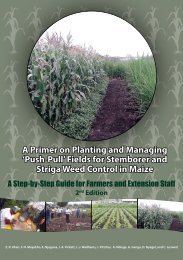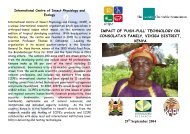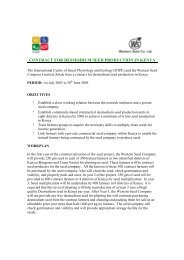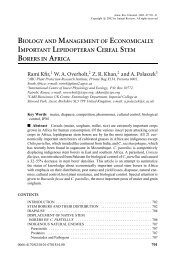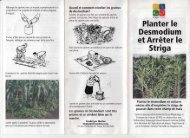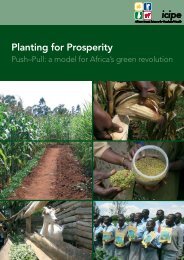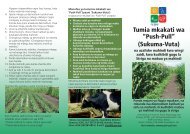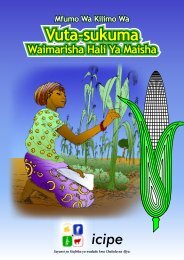The Royal Society Report - Push-Pull
The Royal Society Report - Push-Pull
The Royal Society Report - Push-Pull
Create successful ePaper yourself
Turn your PDF publications into a flip-book with our unique Google optimized e-Paper software.
It is possible to recycle phosphorus (super phosphate<br />
fertiliser, produced by treating animal bones with<br />
sulphuric acid was the first synthetic fertiliser), particularly<br />
from animal sources. However, loss to water and<br />
adsorption in soil mean that the supply of phosphorus in<br />
agricultural systems needs to be continuously replenished;<br />
mined rock phosphate represents the only substantial<br />
supply. <strong>The</strong> primary rock phosphate reserves in North<br />
America, North and South Africa, Russia and southeast<br />
Asia are likely to be exhausted before the end of the<br />
21st century if trends continue (Smil 2000b; Zapata &<br />
Roy 2004).<br />
2.6.2 Secondary, micro and functional<br />
crop nutrients<br />
In different crops and cropping systems as well as different<br />
regions, yield and quality can be constrained by the<br />
availability in soil of nutrients that are required by crops in<br />
small concentrations. Deficiencies of sulphur (S), calcium<br />
(Ca) and magnesium (Mg) which are classed as secondary<br />
nutrients cause significant yield reductions in some crops<br />
and regions.<br />
<strong>The</strong>re are six micronutrients essential for plant growth:<br />
boron (B); copper (Cu); Iron (Fe); manganese (Mn);<br />
molybdenum (Mo) and Zinc (Zn). Micronutrient deficiency<br />
can usually be rectified when diagnosed and the<br />
significance of elevating the levels of some of these<br />
elements (eg Fe) in crops relates to their importance in<br />
human nutrition as much as crop nutrition.<br />
<strong>The</strong>re are five elements considered to be functional in<br />
plants but not essential: sodium (Na); vanadium (V); cobalt<br />
(Co); silicon (Si) and chlorine (Cl). Of these, Si has<br />
relevance in the context of crop production as a competitor<br />
for arsenic (As) uptake (Ma et al. 2008). Arsenic may<br />
accumulate at dangerous levels in the diets of those who<br />
depend on rice grown in soil and water containing high As<br />
concentrations and low Si.<br />
2.7 Pests, diseases and weed competition<br />
Pests, diseases and weeds have a significant impact on the<br />
sustainability of food crop production. Disease-induced<br />
losses essentially represent wasted inputs of energy, water,<br />
nutrients and labour. Worldwide crop losses due to weeds,<br />
pests and diseases have been estimated for eight major<br />
crops (wheat, barley, rice, maize, soy, cotton, sugar beet<br />
and potato) as 26–40%. In the absence of control<br />
measures such as resistant varieties, crop protection<br />
chemicals and crop rotations, losses would be 50–80%<br />
(Oerke & Dehne 2004).<br />
Locusts, larvae of Lepidoptera, and other herbivorous<br />
chewing insects can cause very substantial crop losses as<br />
can root-attacking nematodes and sucking insects such as<br />
aphids and leaf-hoppers; the latter are also important<br />
vectors of diseases caused by viruses and phytoplasma.<br />
Corn borer and corn rootworm cause much damage;<br />
rootworm also affects nitrogen and WUE by damaging the<br />
root system. Damage to cobs by corn borers facilitates the<br />
entry of fungi such as Fusarium and Aspergillus species<br />
that contaminate the seed with poisonous mycotoxins.<br />
Many crops, especially fruit and vegetables, are prone to<br />
rot after harvest and before or during transport to<br />
consumers. Seeds from cereal and legumes are prone to<br />
losses from bruchid beetles, grain and meal moths.<br />
Temperature and humidity control can reduce, though not<br />
eliminate, these losses.<br />
Arthropods and nematodes can also act as disease vectors.<br />
Aphids and leaf hoppers, for example, can act as vectors of<br />
viruses and phytoplasmas. Many different genera of<br />
nematodes cause plant disease, usually by infecting and<br />
colonising roots. Feeding occurs through a hollow stylet<br />
that can penetrate plant cell walls. Most are endoparasites,<br />
invading root tissues and carrying out most of their feeding<br />
from inside the root. Two genera of endoparasitic<br />
nematodes are the source of much crop damage in wheat,<br />
potato, soya beans and many other crops. <strong>The</strong>se are the<br />
cyst nematodes (Heterodera sp. and Globodera sp.) and<br />
root knot nematodes (Meloidogyne sp.). Nematodes are<br />
particularly difficult to control with pesticides. Soil<br />
fumigation with methyl bromide has been widely used until<br />
recently, but the use of this toxic chemical is now severely<br />
restricted although there are few alternatives.<br />
Vertebrate pests are also a significant problem. Rodents<br />
and other large herbivores can inflict significant losses on<br />
crops during their growth and development as well as post<br />
harvest. In industrialised countries, these losses are usually<br />
adequately controlled by regulating the populations of rats,<br />
rabbits or deer using poisons, gassing or shooting. In<br />
developing countries, recourse to such methods of control<br />
is more limited and losses can be considerable in field as<br />
well as plantation crops (Sridhara 2006).<br />
2.7.2 Diseases<br />
Diseases have an impact on loss of crops, pre and post<br />
harvest. <strong>The</strong>re is a cost associated with their control<br />
through crop-protective chemistry and resistant varieties.<br />
Significant losses are caused to crop yields from a variety<br />
of fungi and oomycetes (microscopic fungus-like<br />
organisms), bacteria and viruses across a range of crops.<br />
Some examples are summarised in Table 2.2.<br />
2.7.1 Pests<br />
Pests can cause significant losses of food production,<br />
and there are chemical and non-chemical approaches to<br />
minimising these losses (Yudelman et al. 1998). Table 2.1<br />
lists the major pests of maize, rice and wheat.<br />
2.7.3 Weed competition<br />
Among biotic constraints on crop protection, weeds have<br />
the highest loss potential (32%), followed by pests and<br />
pathogens (18 and 15% respectively) (Oerke & Dehne<br />
2004). Losses due to weed competition represent a<br />
16 I October 2009 I Reaping the Benefits <strong>The</strong> <strong>Royal</strong> <strong>Society</strong>



